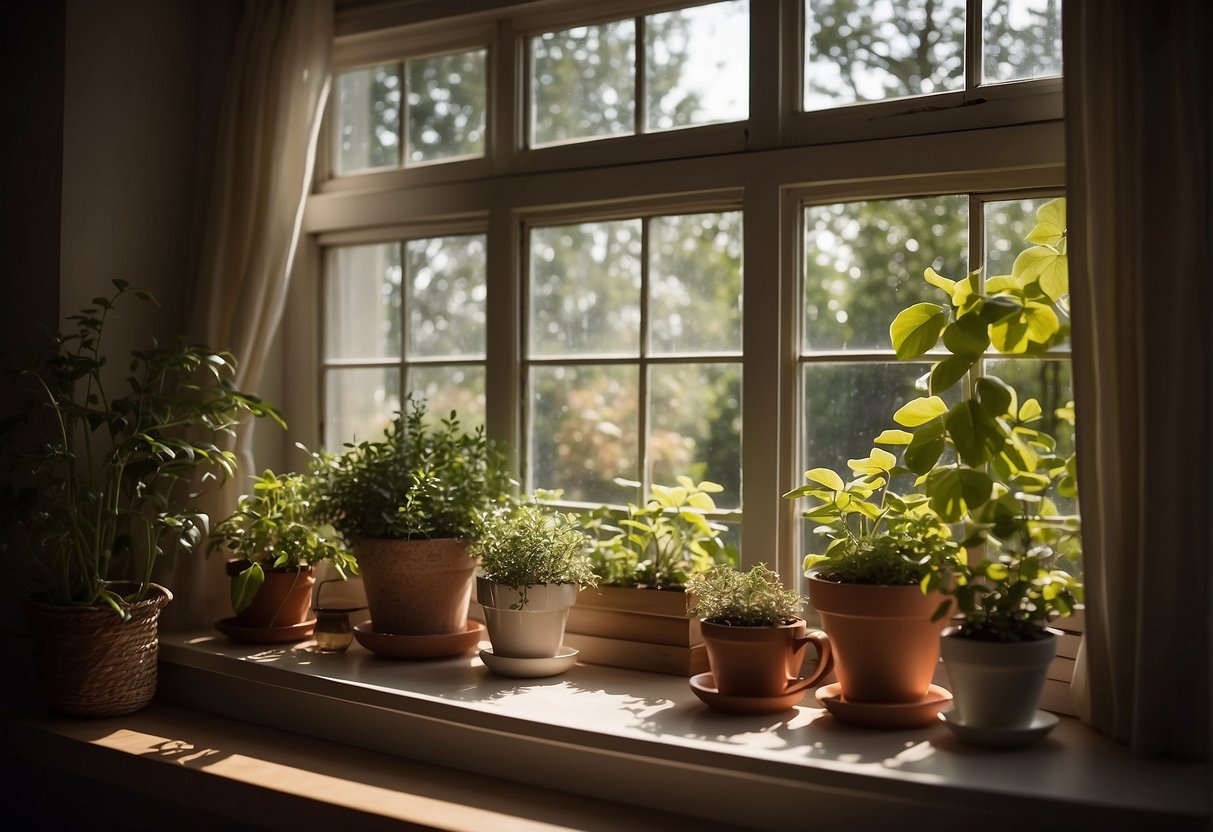Garden windows are an innovative window style that takes the concept of a traditional window further by extending outward from the wall of a home to provide a three-dimensional space often used for growing plants. This style not only contributes to the aesthetic value of a home by introducing architectural interest and enhancing curb appeal but also serves a functional purpose similar to that of a miniature greenhouse.
The structure typically includes a glass front, sides, and a sloping roof to maximize light exposure and aid with rain run-off. This ensures your plants receive plenty of sunlight while staying protected from the elements.

When pondering over the addition of garden windows to your home, consider the unique advantages they offer. This particular window style can facilitate growing herbs or keeping decorative plants, providing greenery and freshness to the room – essentially bringing a piece of the outdoors inside.
However, it’s crucial to weigh the functionality suited to your lifestyle and the logistical aspects such as space requirements, installation logistics, and maintenance demands. You should reflect on the benefits of enhanced light and space against the potential for higher costs and the suitability to your home’s architectural style.
Key Takeaways
- Garden windows enhance a home by providing a space for plants and increasing natural light.
- Assess the practicality of garden windows for your living situation, considering the required care and space.
- Careful installation and understanding of potential limitations ensure satisfaction with garden windows.
Exploring Garden Windows

Garden windows are an innovative addition to your home that combines the sunlight of a greenhouse with the function of a window.
Defining Garden Windows
Garden windows are box-shaped windows that protrude outward from your home’s wall. They consist of:
- Glass sides: Ensuring ample sunlight from almost every angle.
- Sloping glass roofs: Allowing for rain run-off and additional light entry.
- Multi-dimensional space: Ideal for growing plants or displaying decor.
This design creates a small, greenhouse-like environment, perfect for letting in sunlight and giving plants the nourishment they need without having to step outside.
Benefits of Garden Windows
When considering garden windows, you’ll find several key advantages:
- Enhanced Natural Light: With glass on all sides, these windows allow for a significant increase in sunlight entering your home, which can reduce your need for artificial lighting.
- Energy Efficiency: Properly installed garden windows can help insulate your home, potentially leading to savings on energy bills.
- Aesthetic Appeal: They add a unique visual element to your home’s exterior and interior.
- Increased Ventilation: Many garden windows come with side vents that can be opened to allow fresh air to circulate.
- Extra Shelf Space: The extended sill of a garden window provides additional space for plants or decorative items.
It’s important to remember that garden windows do need proper support due to their weight and structure, and they’re best suited for areas where there’s no external obstruction, like walkways or patios.
Choosing Garden Windows

When selecting garden windows for your home, you need to balance functionality with aesthetics to make the best choice that suits your needs.
Factors to Consider
- Energy Efficiency: Look for garden windows with energy-saving features like low-E coatings or argon gas fills to help reduce your heating and cooling costs.
- Ventilation: Ensure your garden window can open—typically through side vents—to allow for airflow and prevent condensation.
- Space Requirements: Measure the available area extensively, as garden windows protrude from the wall and require additional space outside.
- Shelf Capacity: Consider how much weight the shelves can hold if you plan to use them for heavier plants.
Material and Design Preferences
- Material:
- Vinyl: Durable, low-maintenance, and offers good insulation.
- Aluminum: Strong and lightweight, but less insulating than vinyl or wood.
- Wood: Excellent insulator with a classic look, but requires more upkeep to prevent decay.
- Design:
- Select a design that complements your home’s architecture.
- Customizable options may include grid designs, shelf layouts, and frame colors.
Installation Insights

When choosing a garden window, understanding the installation process is as important as the window itself. Proper installation ensures longevity and efficiency, whereas a poor setup can lead to issues down the line.
Professional Versus DIY Installation
Professional Installation:
- Experience: A professional installer will have the expertise to tackle potential challenges that may arise during installation, such as structural integrity or weatherproofing.
- Tools and Materials: Professionals come equipped with the right tools and high-quality materials to ensure a seamless fit.
- Time Efficient: Relying on a professional can significantly accelerate the installation process compared to doing it yourself.
- Warranty: Many professional installations come with a warranty, not only on the window but on the workmanship as well.
DIY Installation:
- Cost Savings: By installing the window yourself, you may save on labor costs associated with professional installation.
- Personal Satisfaction: Completing the installation on your own can provide a sense of achievement and personalization to the project.
Considerations for DIY:
- Ensure you have a clear understanding of the installation process.
- Verify that you possess or can borrow the necessary tools.
- Be prepared to address any unexpected challenges that you might not encounter in a standard window installation.
Note: A garden window installation can be complex due to its box-like structure and need for proper sealing and support. If you’re not experienced in window installation, it’s advisable to opt for professional installation to avoid costly mistakes.
Potential Drawbacks

While garden windows add charm and functionality to your home, you should consider a few potential downsides before making your decision.
Considerations for Space and Utility
Garden windows protrude from the house, providing a unique space for plants or decor. Before you opt for one, ensure your home’s exterior has enough clearance without obstructing paths or outdoor living areas. Inside, think about the window’s depth and how it will affect the room’s layout and utility.
Maintenance Required
These windows require regular cleaning due to their design, which includes more glass panes than a standard window. Maintenance includes ensuring the sealing remains intact to prevent leaks and checking for any signs of wear that might compromise your home’s energy efficiency or the window’s structure.
Conclusion

Choosing garden windows can elevate the aesthetics of your home and provide unique benefits. You enjoy increased natural light and the opportunity to grow plants indoors. They’re especially great if you’re an enthusiast of indoor gardening or simply love to have fresh herbs at hand.
When selecting a garden window, here are key points to remember:
- Functionality: Look for windows with side vents for proper ventilation.
- Energy Efficiency: Opt for modern, energy-efficient models to help reduce your energy bills.
- Design: Ensure the window complements your home’s architectural style.
Keep in mind that garden windows do protrude from your home’s exterior. This means they aren’t suitable for high-traffic areas outside your house due to the potential for damage. They also might not match every home design or personal taste, and the initial investment can be higher than traditional windows.
If these factors align with your preferences and home setup, a garden window could be a delightful addition to your living space. If not, there are many other window styles that might better suit your needs.
Frequently Asked Questions

These FAQs are designed to help you understand the basics of garden windows and assist you in making the best decision for your home.
What are the benefits of installing a garden window in my home?
Garden windows offer a unique way to enhance natural light in your home and create a miniature greenhouse effect which is perfect for growing herbs or flowers. They can also improve your home’s aesthetics and may contribute to energy savings by reducing the need for electric lighting during the day.
How do I create a do-it-yourself garden window for my kitchen?
Creating a DIY garden window can be a rewarding project. You’ll need to measure your space carefully, choose durable materials to withstand the elements, and ensure proper sealing to prevent water damage. Consider consulting a professional for advice or detailed plans to ensure a successful installation.
What should I consider when looking for an affordable garden window?
When seeking an affordable garden window, it’s crucial to consider size, glass type, and the presence of functional vents. Look for deals or discounts from reputable suppliers, and don’t compromise on quality installation, as this can affect the window’s longevity and performance.
Can you recommend some creative garden window decorating ideas?
To personalize your garden window, consider installing shelves for potted plants or herbs. You may also hang decorative ornaments or arrange colorful glass jars that catch the sunlight. Seasonal decorations can add a festive touch to your kitchen or living space.
How much can I expect to spend on a new garden window installation?
The cost of garden window installation typically ranges from $1,000 to $4,000, including materials and labor. Factors influencing the cost include the window’s size, glass options, shelving, and trim choices. Always get a quote from a professional to understand the costs associated with your specific project.
What distinguishes a garden window from a bay window in terms of structure and use?
Both garden and bay windows protrude from the home’s exterior. A garden window is specifically designed to function like a small greenhouse with glass sides and a sloping glass roof for plants. In contrast, a bay window is larger and creates a more extensive interior space. It often serves as a seating area or to enhance the view.






